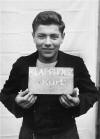
|
Kurt Klappholz |
(Click to enlarge thumbnail)
Kurt Klappholz arrived in England after World War II, having been one of the holocaust victims imprisoned in German concentration camps. He became a naturalised citizen in 1947 and studied at the London School of Economics and Political Science. The picture above shows him at age 152. Part of this background is recounted by the late Professor Eva Kolinsky in her book, After the Holocaust: Jewish Survivors in Germany after 1945.1 When I met Kurt at LSE, one of the first things he showed me was the tattooed number he still retained on his forearm.
Kurt Klappholz's final year at LSE coincided with my first year. We became good buddies. The following year he accepted a post at Columbia University, New York and disappeared from my life only to reappear some years later upon return to London to take up an appointment as Professor of Economics at the LSE. How he got in touch with me again at that time, I cannot recall, but certainly it was once again that period in the mid- to late-1950s when I was living in Hornsey and had enough room to accommodate others- none of whom were sharing the house with me at the time, because he became my housemate, staying with me for about one year. He was a delightful person and a good friend.
And, as so often happens, it is the small things that have stayed in memory. Above all, I associate certain improvements in my way of life to his influence - or perhaps more correctly, to the American influence he had introjected. Among these were my installation of a (primitive) shower in the ground floor scullery* to augment the basic bathroom on the first floor. Following his time in New York, a shower had become an essential part of his daily toiletry. He also introduced me to the magic of "nylon". This product had arrived in the UK some time after its general use in the United States. Kurt was amazed that I was still washing my cotton shirts, hanging them up to dry, and then ironing them. Nylon shirts just had to be washed in soapy warm water, and then hung on a line (in that ubiquitous scullery) to dry. And needed no ironing!
In fact, the main area of disagreement between us (never dispute, merely friendly banter) concerned my (to Kurt's mind) predisposition to punctiliousness. He accused me of being - and this was my first introduction to the expression that he had also, I presume, brought back across "the Pond" - an obsessive compulsive neurotic. This was simply because I preferred a tidy house to an untidy one, and he felt that life was too short to waste on such "trivialities" as cleaning, dusting and tidying up. Astonishingly, many years later, when my housemate was my friend Sasha (both of us between wives!), I was accused of precisely the opposite because I had amassed dozen of empty bottles in that ubiquitous scullery which he insisted be disposed of. Bottle banks did not exist in those days, but he managed to get rid of them. I accused him of being obsessively compulsive!
I saw Kurt one more time, in the 1980s, when I arranged to meet him at LSE for lunch. At this time he was Warden for the Halls of Residence. It was good to meet up again, but somewhat strange that all we now had to discuss was what we had done in the intervening decades, although we did indulge in a bit of "do you remember. . . ?" And generally failing to do so, because I guess we both had retained memories of trivialities that were different for each of us.
But, trivialities aside I have always retained the sense that Kurt Klappholz was one of the most intellectually honest people I have known, and - given the background from which he sprang - effectively heroically so!
Some years later I heard that he had died.
You were more important to me than you realised Kurt, and I treasure the memory of our friendship.
1 After the Holocaust: Jewish Survivors in Germany after 1945, by Eva Kolinsky, 2005. EAN: 9781844133178
* This would nowadays be called a "utility room".
2 Picture acknowledged to United States holocaust survivors site: http://collections.ushmm.org/search/catalog/pa16696